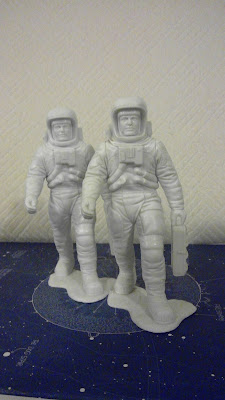We're now in part 3 of a series on giant Marx figures, and finally up to what started this: The Marx astronaut line, possibly the most iconic and influential of their creations, and all the more so because casual collectors frequently identify items from completely different manufacturers as part of it. To summarize very briefly, Marx produced "army man" scale astronaut figures throughout the 1950s and 1960s, many of which were a bit fanciful or "retro" even for the time. As the moon landing became a likely reality, Marx conceived something quite different that would be remembered much longer: In place of space men with fishbowl helmets and ray guns, they designed detailed astronauts in modern-looking suits with plausible scientific gear and instruments. In 1970, the world saw the new realistic astronauts in the full glory of 6 inch scale, of which I have acquired five in three different sculpts. Here's a few more sample pics, with the Truckstop Queen and her companion Ken R. Wampa:
I did discover some more quantifiable variations, which proved easiest to discern in the "backpacks". The most striking is that the "duplicate" Scooper has a quite distinct bulging pack that I suspect represents an earlier version of the mold despite the figure's less aged appearance; unfortunately, it proved quite difficult to capture in photos. I include the following picture as the best I could make, with the bulging pack on the right.
Meanwhile, I had already recognized even more dramatic differences in the cameraman, which apart from anything else measured about 1/4 of an inch shorter. The feel and appearance of the plastic was also far more different than for the other figures, with an almost gray or translucent appearance. I absolutely believe this is a later production with cheaper plastic, though it bears the same production mark as the other figures. This was further born out by far more condition issues including the obliteration of detail on the lens clearly visible I photos of other specimens I used for reference. Despite such flaws, the detail is particularly sharp, and I hoped to further confirm a variant by inspection of the pack. At first, I found this inconclusive, but on further inspection, I concluded that the pack appeared straighter and less "deep", probably to (further?) reduce the amount of plastic. Here's more pics that should also give a better view of this and other figures' details.
On final evaluation, the 6 inch astronauts are among the very best of the large size Marx figures, but also give an all too clear picture of the company's troubles through the following decade. By the best available research, production of the figures probably stopped by the mid-1970s, and it is not difficult to guess why. Though they are shorter than many other nominal 6" figures, they are considerably more heavy and robust, which would have been an increasing liability as Marx's profits declined. They also were placed squarely in the path of the evolving action figure format and the coinciding explosion of science fiction-themed toys. On a deeper level, they embodied the ideals of a moment in time which was already passing. By the 1980s, children were no longer satisfied with the idea of space travel as exploration for its own sake, and Marx would not survive long enough to provide other toys or tales.
If there is a happy postscript, it is that the smaller counterparts went on to a better fate. Though some debate when they were first produced, I see no reason to doubt that they were introduced with the large figures in 1970, and they were certainly still in production at the end of the decade, when they surfaced in several of the very last Marx playsets to be produced, including the Galaxy Command set released in 1979 when the company was already in bankruptcy. More importantly, they set a new standard for detail and realism in science fiction toys, and not just for those on the "army man" scale. I am absolutely sure these little guys were the direct basis of any number of toys that will be featured here sooner or later, particularly the infamous Galaxy Laser Team line that has loomed large both in my childhood and adulthood. If imitation is flattery, the Marx astronauts would have their own pyramid, and you could probably build it entirely with plastic from toys that ripped them off.











Fantastic stuff. The old Marx Toys playsets were incredible... such an attention to detail!
ReplyDelete